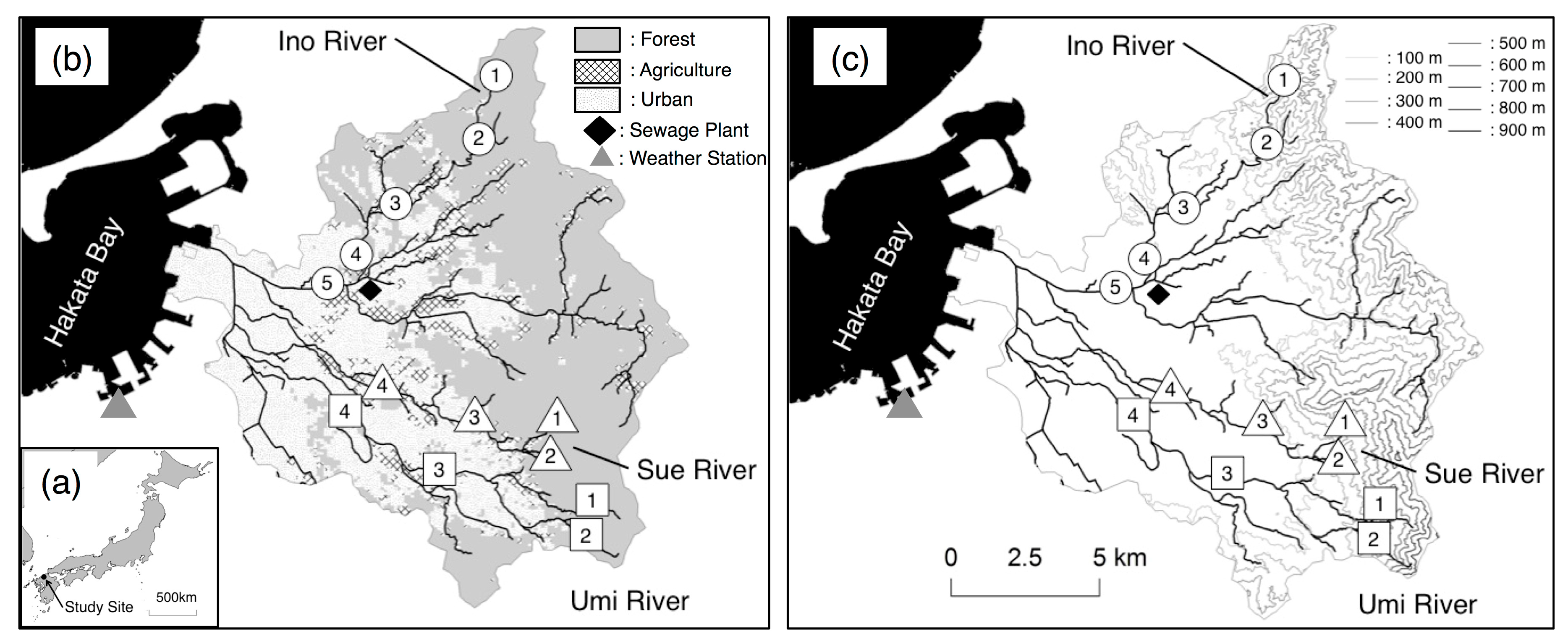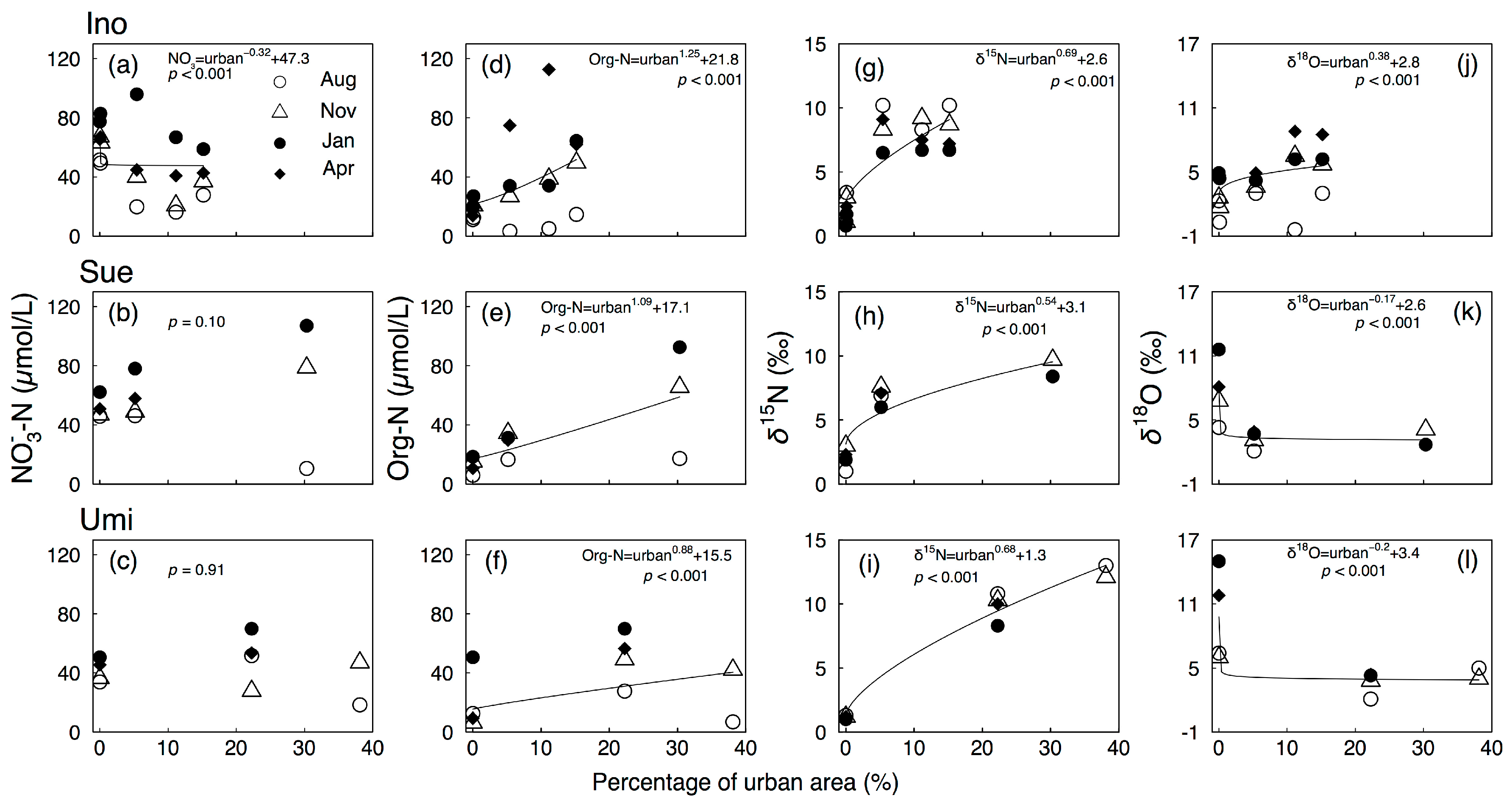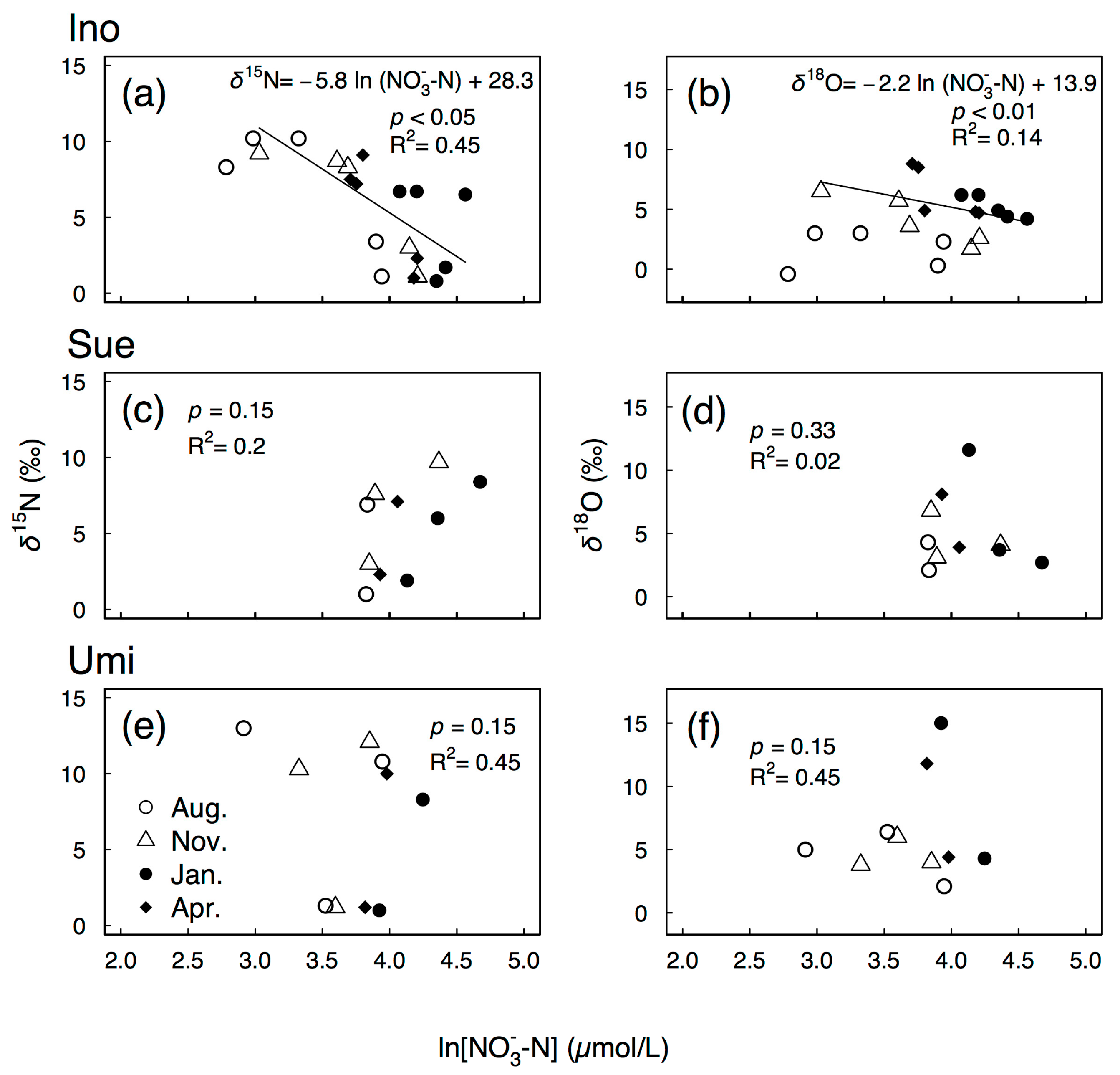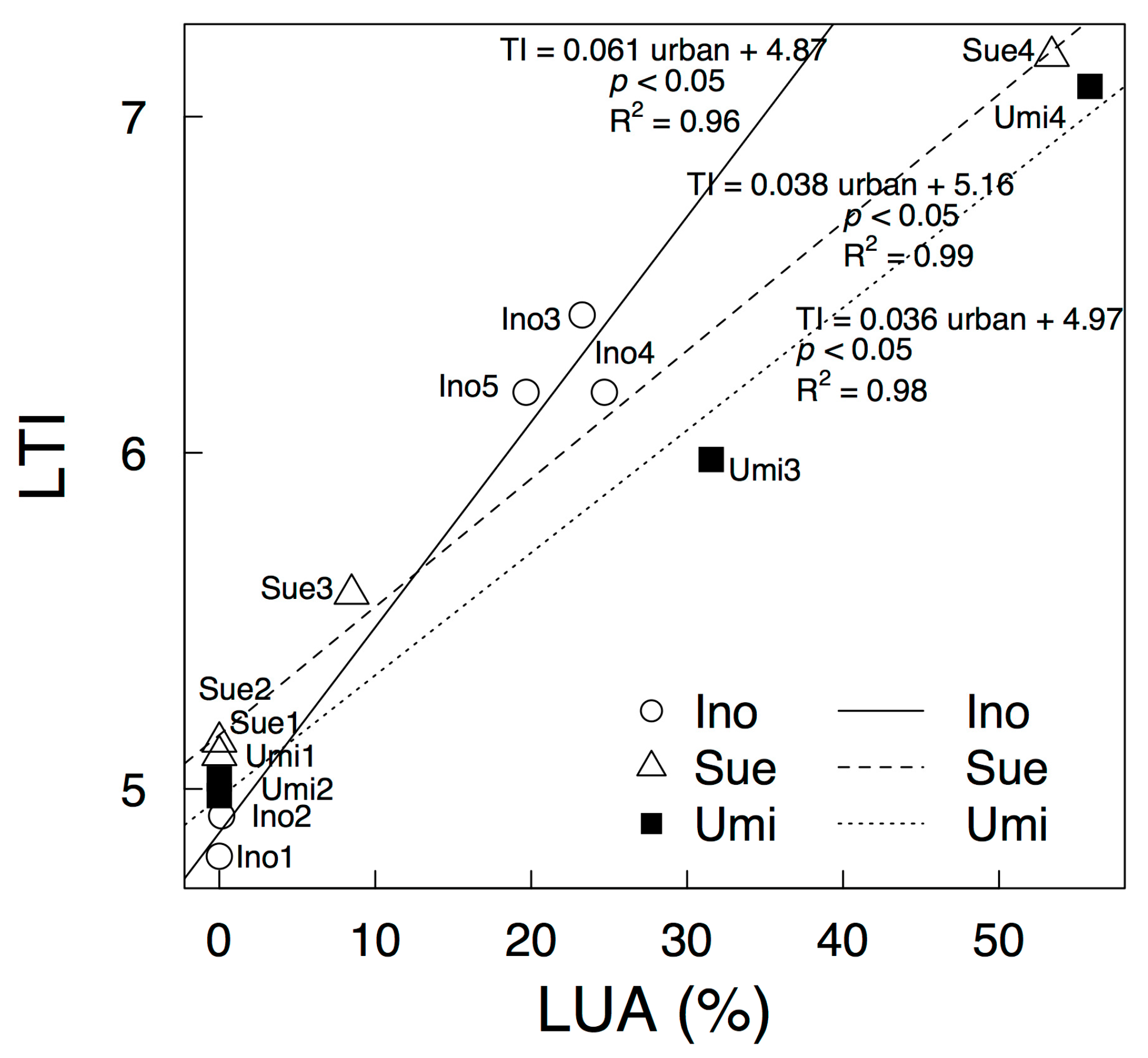Differences in Stream Water Nitrate Concentrations between a Nitrogen-Saturated Upland Forest and a Downstream Mixed Land Use River Basin
Abstract
:1. Introduction
2. Materials and Methods
2.1. Study Area
2.2. Water Sampling and Chemical Analysis
2.3. Geographical Analysis and Topographic Index
2.4. Data Analysis
3. Results and Discussion
3.1. Changes in the NO3−-N Concentration, δ15N and δ18O Upstream and Downstream
3.2. Use of the Topographic Index to Explain the Lower Percentage of Urban Area in Ino
4. Conclusions
Acknowledgments
Author Contributions
Conflicts of Interest
References
- Carpenter, S.R.; Chisholm, S.W.; Krebs, C.J.; Schindler, D.W.; Wright, R.F. Ecosystem experiments. Science 1995, 269, 324–327. [Google Scholar] [CrossRef] [PubMed]
- Swaney, D.P.; Humborg, C.; Emeis, K.; Kannen, A.; Silvert, W.; Tett, P.; Pastres, R.; Solidoro, C.; Yamamuro, M.; Hénocque, Y.; et al. Five critical questions of scale for the coastal zone. Estuar. Coast. Shelf Sci. 2012, 96, 9–21. [Google Scholar] [CrossRef]
- Carpenter, S.R.; Caraco, N.F.; Correll, D.L.; Howarth, R.W.; Sharpley, A.N.; Smith, V.H. Nonpoint pollution of surface waters with phosphorus and nitrogen. Ecol. Appl. 1998, 8, 559–568. [Google Scholar] [CrossRef]
- Fennessy, M.S.; Cronk, J.K. The effectiveness and restoration potential of riparian ecotones for the management of nonpoint source pollution, particularly nitrate. Crit. Rev. Environ. Sci. Technol. 1997, 27, 285–317. [Google Scholar] [CrossRef]
- Kaushal, S.S.; Groffman, P.M.; Band, L.E.; Shields, C.A.; Morgan, R.P.; Palmer, M.A.; Belt, K.T.; Swan, C.M.; Findlay, S.E.G.; Fisher, G.T. Interaction between urbanization and climate variability amplifies watershed nitrate export in Maryland. Environ. Sci. Technol. 2008, 42, 5872–5878. [Google Scholar] [CrossRef] [PubMed]
- Howarth, R.W.; Billen, G.; Swaney, D.; Townsend, A.; Jaworski, N.; Lajtha, K.; Downing, J.A.; Elmgren, R.; Caraco, N.; Jordan, T.; et al. Regional nitrogen budgets and riverine N & P fluxes for the drainages to the North Atlantic Ocean: Natural and human influences. Biogeochemistry 1996, 35, 75–139. [Google Scholar] [CrossRef]
- Alvarez-Cobelas, M.; Angeler, D.G.; Sánchez-Carrillo, S. Export of nitrogen from catchments: A worldwide analysis. Environ. Pollut. 2008, 156, 261–269. [Google Scholar] [CrossRef] [PubMed]
- Aber, J.D.; Nadelhoffer, K.J.; Steudler, P.; Melillo, J.M. Nitrogen saturation in northern forest ecosystems: Excess nitrogen from fossil fuel combustion may stress the biosphere. BioScience 1989, 39, 378–386. [Google Scholar] [CrossRef]
- Mitchell, M.J.; Iwatsubo, G.; Ohrui, K.; Nakagawa, Y. Nitrogen saturation in Japanese forests: An evaluationn. For. Ecol. Manag. 1997, 97, 39–51. [Google Scholar] [CrossRef]
- Chiwa, M.; Onikura, N.; Ide, J.; Kume, A. Impact of N-saturated upland forests on downstream N pollution in the Tatara River Basin, Japan. Ecosystems 2012, 15, 230–241. [Google Scholar] [CrossRef]
- Sugimoto, R.; Tsuboi, T. Seasonal and annual fluxes of atmospheric nitrogen deposition and riverine nitrogen export in two adjacent contrasting rivers in central Japan facing the Sea of Japan. J. Hydrol. Reg. Stud. 2015. [Google Scholar] [CrossRef]
- Allan, J.D.; Castillo, M.M. Stream Ecology: Structure and Function of Running Waters; Springer: Dordrecht, The Netherlands, 2007; 436 p. [Google Scholar]
- Ohte, N.; Tayasu, I.; Kohzu, A.; Yoshimizu, C.; Osaka, K.; Makabe, A.; Koba, K.; Yoshida, N.; Nagata, T. Spatial distribution of nitrate sources of rivers in the Lake Biwa watershed, Japan: Controlling factors revealed by nitrogen and oxygen isotope values. Water Resour. Res. 2010, 46, W07505. [Google Scholar] [CrossRef]
- Kendall, C. Tracing Nitrogen Sources and Cycling in Catchments. In Isotope Tracers in Catchment Hydrology; Kendall, C., McDonnell, J.J., Eds.; Elsevier Science: Amsterdam, The Netherlands, 1998; pp. 517–576. [Google Scholar]
- Rock, L.; Mayer, B. Isotopic assessment of sources of surface water nitrate within the Oldman River Basin, Southern Alberta, Canada. Water Air Soil Pollut. Focus 2004, 4, 545–562. [Google Scholar] [CrossRef]
- Nestler, A.; Berglund, M.; Accoe, F.; Duta, S.; Xue, D.; Boeckx, P.; Taylor, P. Isotopes for improved management of nitrate pollution in aqueous resources: Review of surface water field studies. Environ. Sci. Pollut. Res. 2011, 18, 519–533. [Google Scholar] [CrossRef] [PubMed]
- Townsend-Small, A.; McCarthy, M.J.; Brandes, J.A.; Yang, L.; Zhang, L.; Gardner, W.S. Stable isotopic composition of nitrate in Lake Taihu, China, and major inflow rivers. Hydrobiologia 2007, 581, 135–140. [Google Scholar] [CrossRef]
- Miyajima, T.; Yoshimizu, C.; Tsuboi, Y.; Tanaka, Y.; Tayasu, I.; Nagata, T.; Koike, I. Longitudinal distribution of nitrate δ15N and δ18O in two contrasting tropical rivers: Implications for instream nitrogen cycling. Biogeochemistry 2009, 95, 243–260. [Google Scholar] [CrossRef]
- Granger, J.; Sigman, D.M.; Needoba, J.A.; Harrison, P.J. Coupled nitrogen and oxygen isotope fractionation of nitrate during assimilation by cultures of marine phytoplankton. Limnol. Oceanogr. 2004, 49, 1763–1773. [Google Scholar] [CrossRef]
- Deutsch, B.; Voss, M.; Fischer, H. Nitrogen transformation processes in the Elbe River: Distinguishing between assimilation and denitrification by means of stable isotope ratios in nitrate. Aquat. Sci. 2009, 71, 228–237. [Google Scholar] [CrossRef]
- Sigman, D.M.; Casciotti, K.L.; Andreani, M.; Barford, C.; Galanter, M.; Böhlke, J.K. A bacterial method for the nitrogen isotopic analysis of nitrate in seawater and freshwater. Anal. Chem. 2001, 73, 4145–4153. [Google Scholar] [CrossRef] [PubMed]
- Casciotti, K.L.; Sigman, D.M.; Hastings, M.G.; Böhlke, J.K.; Hilkert, A. Measurement of the oxygen isotopic composition of nitrate in seawater and freshwater using the denitrifier method. Anal. Chem. 2002, 74, 4905–4912. [Google Scholar] [CrossRef] [PubMed]
- Böhlke, J.K.; Mroczkowski, S.J.; Coplen, T.B. Oxygen isotopes in nitrate: New reference materials for 18O:17O:16O measurements and observations on nitrate-water equilibration. Rapid Commun. Mass Spectrom. 2003, 17, 1835–1846. [Google Scholar] [CrossRef] [PubMed]
- Beven, K.J.; Kirkby, M.J. A physically-based, variable contributing area model of basin hydrology/Un modèle à base physique de zone d’appel variable de l’hydrologie du bassin versant. Hydrol. Sci. Bull. 1979, 24, 43–69. [Google Scholar] [CrossRef]
- Shibata, H.; Kuraji, K.; Toda, H.; Sasa, K. Regional comparison of nitrogen export to Japanese forest streams. Sci. World J. 2001, 1, 572–580. [Google Scholar] [CrossRef] [PubMed]
- Zhang, Z.; Fukushima, T.; Shi, P.; Tao, F.; Onda, Y.; Gomi, T.; Mizugaki, S.; Asano, Y.; Kosugi, K.; Hiramatsu, S.; et al. Baseflow concentrations of nitrogen and phosphorus in forested headwaters in Japan. Sci. Total Environ. 2008, 402, 113–122. [Google Scholar] [CrossRef] [PubMed]
- Itoh, Y.; Miura, S.; Kato, M.; Yoshinaga, S. Regional distribution of nitrate concentrations in the stream water of forested watersheds in the Kanto and Chubu Districts. J. Jpn. For. Soc. 2004, 86, 275–278. [Google Scholar] [CrossRef]
- Yoshinaga, S.; Itoh, Y.; Aizawa, S.; Tsurita, T. Variation in nitrate concentrations in streamwater of forested watersheds in the northeastern Kanto plain as a function of distance from the Tokyo Metropolitan area. J. Jpn. For. Soc. 2012, 94, 84–91. [Google Scholar] [CrossRef]
- Chiwa, M.; Enoki, T.; Higashi, N.; Kumagai, T.; Otsuki, K. The increased contribution of atmospheric nitrogen deposition to nitrogen cycling in a rural forested area of Kyushu, Japan. Water Air Soil Pollut. 2013, 224, 1763. [Google Scholar] [CrossRef]
- Chiwa, M.; Maruno, R.; Ide, J.; Miyano, T.; Higashi, N.; Otsuki, K. Role of stormflow in reducing N retention in a suburban forested watershed, western Japan. J. Geophys. Res. Biogeosci. 2010, 115, G02004. [Google Scholar] [CrossRef]
- Díaz, F.J.; O’Geen, A.T.; Dahlgren, R.A. Agricultural pollutant removal by constructed wetlands: Implications for water management and design. Agric. Water Manag. 2012, 104, 171–183. [Google Scholar] [CrossRef]
- Maruyama, T.; Noto, F.; Murashima, K.; Hashimoto, I.; Kitada, K. Analysis of the nitrogen pollution load potential from farmland in the Tedori River alluvial fan areas in Japan. Paddy Water Environ. 2010, 8, 293–300. [Google Scholar] [CrossRef]
- Shinozuka, K.; Chiwa, M.; Nakamura, K.; Nagao, S.; Kume, A. Stream water nitrogen eutrophication during non-irrigated periods in a paddy-dominated agricultural basin in a snowfall area in Japan. Water Air Soil Pollut. 2016, 227, 219. [Google Scholar] [CrossRef]
- Kroeger, K.D.; Cole, M.L.; Valiela, I. Groundwater-transported dissolved organic nitrogen exports from coastal watersheds. Limnol. Oceanogr. 2006, 51, 2248–2261. [Google Scholar] [CrossRef]
- Stanley, E.H.; Maxted, J.T. Changes in the dissolved nitrogen pool across land cover gradients in wisconsin streams. Ecol. Appl. 2008, 18, 1579–1590. [Google Scholar] [CrossRef] [PubMed]
- Kendall, C.; Elliott, E.M.; Wankel, S.D. Tracing anthropogenic inputs of nitrogen to ecosystems. In Stable Isotopes in Ecology and Environmental Science; Michener, R.H., Lajtha, K., Eds.; Blackwell Publishing Ltd.: Oxford, UK, 2008; pp. 375–449. [Google Scholar]
- Cey, E.E.; Rudolph, D.L.; Aravena, R.; Parkin, G. Role of the riparian zone in controlling the distribution and fate of agricultural nitrogen near a small stream in southern Ontario. J. Contam. Hydrol. 1999, 37, 45–67. [Google Scholar] [CrossRef]
- Lehmann, M.F.; Reichert, P.; Bernasconi, S.M.; Barbieri, A.; McKenzie, J.A. Modelling nitrogen and oxygen isotope fractionation during denitrification in a lacustrine redox-transition zone. Geochim. Cosmochim. Acta 2003, 67, 2529–2542. [Google Scholar] [CrossRef]
- Sebilo, M.; Billen, G.; Grably, M.; Mariotti, A. Isotopic composition of nitrate-nitrogen as a marker of riparian and benthic denitrification at the scale of the whole Seine River system. Biogeochemistry 2003, 63, 35–51. [Google Scholar] [CrossRef]
- Ogawa, A.; Shibata, H.; Suzuki, K.; Mitchell, M.J.; Ikegami, Y. Relationship of topography to surface water chemistry with particular focus on nitrogen and organic carbon solutes within a forested watershed in Hokkaido, Japan. Hydrol. Process. 2006, 20, 251–265. [Google Scholar] [CrossRef]
- Anderson, T.R.; Groffman, P.M.; Walter, M.T. Using a soil topographic index to distribute denitrification fluxes across a northeastern headwater catchment. J. Hydrol. 2015, 522, 123–134. [Google Scholar] [CrossRef]
- Kulkarni, M.V.; Groffman, P.M.; Yavitt, J.B.; Goodale, C.L. Complex controls of denitrification at ecosystem, landscape and regional scales in northern hardwood forests. Ecol. Model. 2015, 298, 39–52. [Google Scholar] [CrossRef]
- Olyaie, E.; Banejad, H.; Chau, K.W.; Melesse, A.M. A comparison of various artificial intelligence approaches performance for estimating suspended sediment load of river systems: A case study in United States. Environ. Monit. Assess. 2015, 187. [Google Scholar] [CrossRef] [PubMed]
- Wang, W.C.; Xu, D.M.; Chau, K.W.; Lei, G.J. Assessment of river water quality based on theory of variable Fuzzy sets and Fuzzy Binary comparison method. Water Resour. Manag. 2014, 28, 4183–4200. [Google Scholar] [CrossRef]
- Chen, X.Y.; Chau, K.W. A Hybrid double feedforward neural network for suspended sediment load estimation. Water Resour. Manag. 2016, 30, 2179–2194. [Google Scholar] [CrossRef]
- Sefeedpari, P.; Rafiee, S.; Akram, A.; Chau, K.W.; Pishgar-Komleh, S.H. Prophesying egg production based on energy consumption using multi-layered adaptive neural fuzzy inference system approach. Comput. Electron. Agric. 2016, 131, 10–19. [Google Scholar] [CrossRef]





| June | July | August | September | October | November | December | January | February | March | April | May | Annual | |
|---|---|---|---|---|---|---|---|---|---|---|---|---|---|
| Temperature (°C) | 23.1 | 28.0 | 29.1 | 24.5 | 19.2 | 12.9 | 7.6 | 6.1 | 7.8 | 12.3 | 14.7 | 20.3 | 17.1 |
| Precipitation (mm) | 289 | 464 | 189 | 129 | 48 | 125 | 99 | 58 | 82 | 57 | 108 | 37 | 1685 |
| Site | Watershed Area (km2) | River Width (m) | Gradient of River Bed (°) | Land Use (%) | |||||
|---|---|---|---|---|---|---|---|---|---|
| Forest | Paddy | Farmland | Urban | River | Others | ||||
| Ino1 | 3.4 | 8.0 | 7.00 | 100.0 | 0.0 | 0.0 | 0.0 | 0.0 | 0.0 |
| Ino2 | 10.4 | 7.6 | 6.00 | 97.1 | 0.3 | 0.0 | 0.1 | 1.5 | 1.0 |
| Ino3 | 14.2 | 9.2 | 0.60 | 86.8 | 3.9 | 0.7 | 6.3 | 1.3 | 1.1 |
| Ino4 | 26.4 | 23.2 | 0.38 | 74.9 | 6.1 | 1.2 | 14.8 | 1.8 | 1.2 |
| Ino5 | 93.8 | 34.6 | 0.05 | 69.2 | 8.0 | 0.7 | 18.3 | 1.6 | 2.2 |
| Sue1 | 2.5 | 9.4 | 3.66 | 100.0 | 0.0 | 0.0 | 0.0 | 0.0 | 0.0 |
| Sue2 | 0.7 | 4.2 | 5.25 | 99.5 | 0.0 | 0.0 | 0.0 | 0.0 | 0.5 |
| Sue3 | 8.9 | 14.3 | 1.17 | 87.3 | 5.9 | 0.2 | 6.1 | 0.2 | 0.2 |
| Sue4 | 21.6 | 23.0 | 0.29 | 53.7 | 9.8 | 0.7 | 30.3 | 1.8 | 3.6 |
| Umi1 | 2.1 | 4.2 | 6.05 | 99.8 | 0.0 | 0.0 | 0.0 | 0.0 | 0.2 |
| Umi2 | 0.3 | 2.0 | 10.28 | 100.0 | 0.0 | 0.0 | 0.0 | 0.0 | 0.0 |
| Umi3 | 14.9 | 21.7 | 1.45 | 68.0 | 4.1 | 0.0 | 27.1 | 0.5 | 0.4 |
| Umi4 | 35 | 26.6 | 2.97 | 49.1 | 5.4 | 0.2 | 38.1 | 0.9 | 6.4 |
© 2017 by the authors. Licensee MDPI, Basel, Switzerland. This article is an open access article distributed under the terms and conditions of the Creative Commons Attribution (CC BY) license (http://creativecommons.org/licenses/by/4.0/).
Share and Cite
Shinozuka, K.; Chiwa, M.; Tayasu, I.; Yoshimizu, C.; Otsuki, K.; Kume, A. Differences in Stream Water Nitrate Concentrations between a Nitrogen-Saturated Upland Forest and a Downstream Mixed Land Use River Basin. Hydrology 2017, 4, 43. https://doi.org/10.3390/hydrology4030043
Shinozuka K, Chiwa M, Tayasu I, Yoshimizu C, Otsuki K, Kume A. Differences in Stream Water Nitrate Concentrations between a Nitrogen-Saturated Upland Forest and a Downstream Mixed Land Use River Basin. Hydrology. 2017; 4(3):43. https://doi.org/10.3390/hydrology4030043
Chicago/Turabian StyleShinozuka, Ken’ichi, Masaaki Chiwa, Ichiro Tayasu, Chikage Yoshimizu, Kyoichi Otsuki, and Atsushi Kume. 2017. "Differences in Stream Water Nitrate Concentrations between a Nitrogen-Saturated Upland Forest and a Downstream Mixed Land Use River Basin" Hydrology 4, no. 3: 43. https://doi.org/10.3390/hydrology4030043





